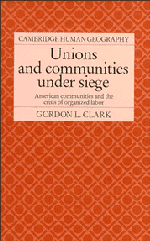Book contents
- Frontmatter
- Contents
- List of tables
- Preface
- Acknowledgments
- PART I ECONOMY AND COMMUNITY
- PART II DRAMA OF ECONOMIC RESTRUCTURING
- PART III UNION PERFORMANCE IN REPRESENTATION ELECTIONS
- PART IV REGULATING LOCAL LABOR–MANAGEMENT RELATIONS
- PART V PROSPECTS FOR ORGANIZED LABOR
- 10 Republicans, Democrats, and the southern veto
- 11 Employment contracts without unions
- 12 Unions and communities unarmed
- Appendix 1 Variables and data sources
- Appendix 2 Cases cited
- Notes
- Bibliography
- Name index
- Subject index
12 - Unions and communities unarmed
Published online by Cambridge University Press: 13 October 2009
- Frontmatter
- Contents
- List of tables
- Preface
- Acknowledgments
- PART I ECONOMY AND COMMUNITY
- PART II DRAMA OF ECONOMIC RESTRUCTURING
- PART III UNION PERFORMANCE IN REPRESENTATION ELECTIONS
- PART IV REGULATING LOCAL LABOR–MANAGEMENT RELATIONS
- PART V PROSPECTS FOR ORGANIZED LABOR
- 10 Republicans, Democrats, and the southern veto
- 11 Employment contracts without unions
- 12 Unions and communities unarmed
- Appendix 1 Variables and data sources
- Appendix 2 Cases cited
- Notes
- Bibliography
- Name index
- Subject index
Summary
We have come a long way in this book. It began with a brief statement on the importance of a community-oriented perspective for understanding the current crisis of organized labor, and moved quickly to two case studies which sketched some of the basic issues. This relatively simple presentation of the book's underlying thesis was replaced chapter by chapter with more complex interpretations of the intersection between unions and communities. In this way, other ingredients were added to my thesis and were evaluated in terms of their significance. Included were analyses of the impacts of geographical and economic restructuring and the tensions involved in orchestrating international union solidarity. From empirical models of unions' performance in representation elections through to detailed case studies of institutions and the status of labor law, my goal was to illustrate the many different ways of understanding the union–community connection.
At the outset I noted that no one test of the union–community connection would be introduced to demonstrate its utility for understanding the current crisis of organized labor. In this sense, I do not claim to have proved my case, as a simple-minded empiricist might want me to proclaim. Indeed, the various ways shown of conceptualizing the union–community connection should be reason enough to suppose that any one test would be inadequate. Nevertheless, by itself each way of illustrating the union–community connection provides an empirical perspective on the problems facing the American labor movement.
- Type
- Chapter
- Information
- Unions and Communities under SiegeAmerican Communities and the Crisis of Organized Labor, pp. 239 - 253Publisher: Cambridge University PressPrint publication year: 1989

